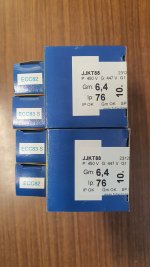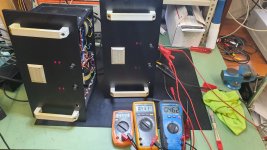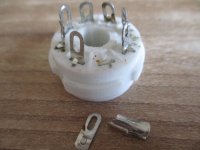Hi Masa1897,
I don’t see the led’s in the pictures you posted, so I still don’t see how you added the opamps with the leds to your circuit.
Regards, Gerrit
I don’t see the led’s in the pictures you posted, so I still don’t see how you added the opamps with the leds to your circuit.
Regards, Gerrit
Hi, there is no exact schematic of this module, what's can you found online I've already posted. Made some pictures of this module.I don’t see the led’s in the pictures you posted, so I still don’t see how you added the opamps with the leds to your circuit.
Now I must understand why it explode one tube and took resistor. I hope it is not the OT
Last edited by a moderator:
The 10 Ohm cathode resistors in each KT88 are also not in the schematic. (I could have saved posting my pic !!)
Vì vậy, bây giờ chủ đề này cũng có thể được sửa chữa 🤣.
Hôm nay tôi đã thay đổi điện trở từ lưới 2 của KT88 sang OT. Và bây giờ tôi có thể điều chỉnh độ lệch trên cả hai bóng đèn😏, nhưng không lâu, nó kết thúc bằng một màn pháo hoa ngoạn mục bên trong một trong KT88😅. Và nó cũng lấy điện trở lưới 2, mà tôi đã thay thế và lắp đặt ban đầu đã bị cháy. Tôi đã sửa chữa nhiều bộ khuếch đại đèn và chế tạo một số, tôi nghĩ rằng đây có vẻ là một KT88 bị lỗi. OT có lẽ ổn, nhưng tôi cần phải đo nó. Và một số hình ảnh của bộ khuếch đại, những thứ màu trắng bên trong KT88 sau màn pháo hoa)
Like something wrong here. Because as the photo is still visible is 150 Ohm( 150 Ohm x2) > 100 Ohm ( 100 Ohm x2) old... And the return has burned... Kt88 also burned flash G2. So maybe you chose a large Ia current leading to G2 as well as damaging Kt88 and burning the return... So now need to find another good Kt88 and return the grid resistance value G2 to 2 x 100 Ohm, re-adjust Vr2 (VR3) so that the current through the 10 Ohm resistor is only about 50mA (10 Ohm x 50 mA = 500mV)
Originally on grid 2 was 270 Ohm resistors, couldn't find them, so took 2 150 Ohm in series. I don't think 30 Ohm makes huge difference. Current was about 40 mA when two LEDs lights on simultaneously. Another tube have had same conditions and not blow up, so I think KT88 is bad. I replace this pair with working ones from second mono amp, which have no problems.
For safety, when circuit operation is in doubt and considering the dangerous Joules present on the smooting caps on power up, I always disconnect the HV secondary from the transformer, then check all other operative boundary conditions i.e negative volts are correct on the sockets BEFORE fitting another set of o/p tubes. If things aren´t right then better to check all before another set of expensive tubes are destroyed.
Checking includes any leaky interstage caps, shown on the circuit diagram rated as 400V, when considerably more could be present at switch on when neg bias volts are also present. In these types of circuit when power up B+volts is near instantaneous it could be over the rated cap value, I would fit min 650V rated components as standard.
Bench Baron
Checking includes any leaky interstage caps, shown on the circuit diagram rated as 400V, when considerably more could be present at switch on when neg bias volts are also present. In these types of circuit when power up B+volts is near instantaneous it could be over the rated cap value, I would fit min 650V rated components as standard.
Bench Baron
Before changing g2 resistors I have checked all voltages and function of bias circuit, all was working as intended. Maybe tomorrow I have more time to work with amps and then I compare parts with working one.
So today I have compared voltages in both amps and they are almost identical. Swapped output tube from working one, they not explode, but preamp tube was bad. Found in stash new ones and it works, more then 30 minuets of playing music without exploding. Now I must order pair of KT88 and 2 sets of input tubes, the are from different manufacturers and pretty old. And only then I can start compare this amps with another and then maybe modify them.
If so, then
1- the money maker has been damaged before and needs to be replaced with another type of tube.
2- your public light bulb has burned brightly as you described before, it is time to replace it with another tube.
3- you should check the skill of the 2 capacitors connecting the driver bulb to the G1 grid of the power tube. If necessary, you should see a good capacitor with the same value of capacitance and voltage of the capacitor (higher voltage value is better)
4- re-adjust the Ia current of Kt88 when installing a new tube so that the Ia of both bulbs is equal and about 50mA per bulb.
1- the money maker has been damaged before and needs to be replaced with another type of tube.
2- your public light bulb has burned brightly as you described before, it is time to replace it with another tube.
3- you should check the skill of the 2 capacitors connecting the driver bulb to the G1 grid of the power tube. If necessary, you should see a good capacitor with the same value of capacitance and voltage of the capacitor (higher voltage value is better)
4- re-adjust the Ia current of Kt88 when installing a new tube so that the Ia of both bulbs is equal and about 50mA per bulb.
Last edited by a moderator:
I can't see any reason why you couldn't run the KT88s much hotter, like 70mA per tube to get you close to Class A territory. IMO the amp will sound much better.
As with many UL circuits, the Screen voltage is slightly higher than the Plate voltage.
And, the screen voltage is not that far from the maximum rated screen voltage.
70mA may be a reliable quiescent setting, or may not be a reliable setting.
And, the screen voltage is not that far from the maximum rated screen voltage.
70mA may be a reliable quiescent setting, or may not be a reliable setting.
Excuse me, but I think your translator is a little bit broken😊.If so, then
1- the money maker has been damaged before and needs to be replaced with another type of tube.
2- your public light bulb has burned brightly as you described before, it is time to replace it with another tube.
3- you should check the skill of the 2 capacitors connecting the driver bulb to the G1 grid of the power tube. If necessary, you should see a good capacitor with the same value of capacitance and voltage of the capacitor (higher voltage value is better)
4- re-adjust the Ia current of Kt88 when installing a new tube so that the Ia of both bulbs is equal and about 50mA per bulb.
I too, then two LEDs simultaneously light up it is something like 47 mA per tube and anode is 560 V. Only PSU is limiting factor here, if PT becomes not to hot it's OK. Maybe that's why amp sounding not so good, it is Class AB or worst in Class B.I can't see any reason why you couldn't run the KT88s much hotter, like 70mA per tube to get you close to Class A territory. IMO the amp will sound much better.
After 300 Ohm resistor g2 is 557 V, and max Ug2 is 600 V. So you are right.As with many UL circuits, the Screen voltage is slightly higher than the Plate voltage.
And, the screen voltage is not that far from the maximum rated screen voltage.
Yep, I know, red glowing anode it is not so good for tubes😆.Okay, that's quite high then, so you will have to watch the dissipation.
Did you test it without the output tubes?
Before you put in the new tube, power it on without the output tubes, and make sure the grid bias voltage is about right.
Before you put in the new tube, power it on without the output tubes, and make sure the grid bias voltage is about right.
Just a brief mention of a rare fault which turned out disastrous for a tube.....similiar story of a mysterious fail with runaway anode with loss of sound. Hunting for a faulty component that wasn´t faulty.
One of those Chinese IO ceramic sockets, pin 5 (g1) broke off inside the holder. Broken internally and innocently held in place by components until tube moved, then be quick to turn amp off ! Beware ! It may make temporary contact but these sockets are notoriously loosely constructed and far from being rigid. The consequence was a complete swap of all sockets for more reliable makes.
Bench Baron.
One of those Chinese IO ceramic sockets, pin 5 (g1) broke off inside the holder. Broken internally and innocently held in place by components until tube moved, then be quick to turn amp off ! Beware ! It may make temporary contact but these sockets are notoriously loosely constructed and far from being rigid. The consequence was a complete swap of all sockets for more reliable makes.
Bench Baron.
Attachments
So, I have adjusted bias to 60 mA per KT88 and figured out how to adjust LEDs, now they are lightning simultaneous at 59 mA to 61 mA on tube.
After this sound is much better, but with preamp. Direkt from Bluesound Node it was sounding like something missing in music. I have found old NAD 1130 and it improved sound significantly. How I understand this from technical point of view, this monoblocs needs some kind of buffer between them and source.
Maybe some can suggest me high quality tube buffer or preamp. Thanks 🍻
After this sound is much better, but with preamp. Direkt from Bluesound Node it was sounding like something missing in music. I have found old NAD 1130 and it improved sound significantly. How I understand this from technical point of view, this monoblocs needs some kind of buffer between them and source.
Maybe some can suggest me high quality tube buffer or preamp. Thanks 🍻
Typically, a Williamson amplifier will have low sensitivity and require a healthy drive voltage. My original Williamson-style monoblocks do. There's also good bit of Miller capacitance at the input. I could also be that the amps are very revealing. ;-) They were certainly well-regarded back in the day.
I use an Aikido-style 6SN7 preamp with mine and it's a wonderful match--lots of voltage output and a very linear, low-distortion signal. Using my DAC as a source isn't nearly as satisfactory.
IMO any decent 6SN7 preamp, like an Icon or Cary, would be a good match for a Williamson. Also good would be a triode 6V6 preamp. You definitely want active gain. I personally have a preference for octal preamps.
I use an Aikido-style 6SN7 preamp with mine and it's a wonderful match--lots of voltage output and a very linear, low-distortion signal. Using my DAC as a source isn't nearly as satisfactory.
IMO any decent 6SN7 preamp, like an Icon or Cary, would be a good match for a Williamson. Also good would be a triode 6V6 preamp. You definitely want active gain. I personally have a preference for octal preamps.
- Home
- Amplifiers
- Tubes / Valves
- Bad sounding Grant G100 AMS KT88 Amp


